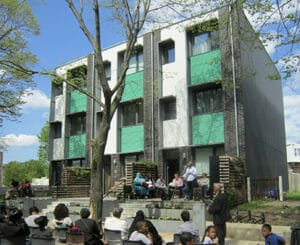Top Story
It has taken 25 years, but Passivhaus—a building design standard with rigorous energy efficiency benchmarks—may be inching closer to the mainstream. Developed in 1990 by German and Swedish researchers, passive structures—those designed to the Passivhaus standard—achieve maximum energy efficiency through an ultra-airtight building envelope, which allows for year-round comfortable interior air temperatures and quality without relying on air conditioners or heating systems.
The technique is now gaining wider traction among property professionals on both sides of the Atlantic as governments pursue ambitious goals to reduce greenhouse gases and private companies seek to create competitive advantages through their commitment to sustainability.
Yet, marketing Passivhaus and other energy-efficient properties to individual consumers remains a challenge, according to Victoria Herring, director of retrofits and refurbishments at Grosvenor Britain & Ireland (GBI), who shared lessons on her firm’s experience retrofitting several London rental homes to the Passivhaus standard in a recent ULI webinar organized by the U.S. and U.K. sustainability councils.
Herring was joined in the presentation by Tim McDonald, a partner at OnionFlats in Philadelphia, and Ken Levenson, a Brooklyn, New York–based architect and partner at 475 High Performance Building Supply, an e-commerce supplier of energy-efficiency products. Both shared experiences of building and designing to the Passivhaus standard in major U.S. markets.
Currently, GBI is three years into a ten-year plan to retrofit its portfolio of 5,000 residential properties in London, located in the Belgravia and Mayfair districts. The U.K. Climate Change Act passed in 2008 requires an 80 percent reduction in carbon emissions from 1990 levels by 2050; to support this mandate, GBI has pledged a 50 percent emissions cut for its portfolio by 2030. “As most of our buildings will exist in 2050, we need to retrofit in order to achieve this U.K. commitment,” Herring said.
One solution that GBI has pursued is retrofitting to the Passivhaus standard. Of the 150 to 200 units the firm retrofits each year, 2 percent are brought up to the EnerPHit standard, a special certification for refurbished buildings. Meeting the EnerPHit standard allows GBI to continue marketing its properties as “best in class,” set clear performance targets for its delivery teams, and help balance the impacts of those “harder to treat” legacy properties in its portfolio, Herring explained.
From the beginning, GBI has approached energy efficiency from the tenant’s perspective.
Ultimately, consumer demand is a prerequisite to create a market for passive dwellings. And there is certainly a cost premium that must be recouped somehow. Herring estimated that the EnerPHit certification retrofit cost 20 percent more than a standard retrofit, which GBI hopes to reduce to 10 percent as research and development on passive structures evolves.
Beyond meeting national climate mitigation goals, “this is about improving the experience of how people feel about being in their properties,” Herring said. “Our Grosvenor brand is about quality, and our occupiers deserve the best levels of comfort and energy efficiency.” GBI’s marketing efforts have emphasized not just energy efficiency and cost savings, but also the “health and comfort benefits” of these new EnerPHit homes, Herring said.
Still, the market reaction has been mixed—mainly due to confusion about what Passivhaus is and whether the benefits can be personal as well as environmental. Through surveys, GBI found that while 32 percent of prospective consumers were willing to pay more for insulation that blocked outdoor noise, just 18 percent were willing to pay for a property that lowered carbon emissions.
“The problem we find here is that the market doesn’t think long-term enough or understand the benefits of Passivhaus,” Herring said. “There’s a disconnect here because people don’t understand that a property with good sound insulation would also have lower carbon emissions.”
Clearly, more public education around Passivhaus and other energy efficiency products is required. In the meantime, GBI is eager to scale up its efforts and possibly retrofit 20 to 30 units to the EnerPHit standard each year. “If we can have a robust business case, we can do more units,” Herring said, who added that two fundamental questions that had to be answered are: “What’s stopping people? And how do we stimulate the demand?”
Gaining Popularity Stateside
In the United States, passive dwellings have begun entering the marketplace as forward-thinking developers, consumers, and public agencies show greater interest in carbon-neutral or “net-zero” homes and workplaces. And it is a good thing, since demand for space will increase exponentially as urban population centers explode around the globe. “By 2030, 900 billion square feet of new and refurbished buildings will be constructed in cities worldwide,” according to McDonald.
Building solutions to meet both carbon reduction goals and the demand for housing will have to be “radical, affordable, and scalable,” according to McDonald, who believes that passive structures can accomplish both objectives. His firm is currently pursuing multiple residential projects in the market-rate and affordable/workforce categories, all of which meet the certification criteria for Passive House—the U.S. version of Passivhaus. One project, Belfield Townhomes, is a set of three and four-bedroom affordable-rate townhomes built for three formerly homeless families in a blighted section of Philadelphia. The buildings were built off site in a modular fashion with solar panels and their own energy recovery system.
“It elevates the standard for affordable housing in this country” and could be a scalable prototype, McDonald said.
The Pennsylvania Housing Finance Agency (PHFA) recently added Passive House certification as an incentive to developers when submitting applications to receive low-income housing tax credits. This year, 30 percent of PHFA-financed projects are expected to be built to passive standards, McDonald said.
Like the U.K. government, New York City Mayor Bill de Blasio has promised an 80 percent reduction in emissions by 2050. In his plan to accomplish this goal, One City: Built to Last, he cites Passive House as a high-performance building standard that developers of market-rate and affordable housing can follow; Knickerbocker Commons, a 24-unit affordable mid-rise building in Brooklyn is featured in the plan as a case study. Acknowledging the challenges of educating the public and marketing passive structures to consumers, Levenson suggested finding out the “hot button issue of your constituents.”
“Big energy savings is the headline grabber,” but affordability, health, comfort, concern over climate change, and resilience also can persuade reluctant consumers, he said. And because Passive House model lays out clear benchmarks for energy production and consumption, the business case for developers is clear, in Levenson’s view: “From a business perspective, you have a pathway forward that is very predictable.”
And there is no reason the passive approach to new construction and retrofits cannot be applied to every structure in the built environment, well beyond homes and offices, Levenson said, giving an example of a German hospital being built to the Passivhaus standard: “The sky is the limit.”


